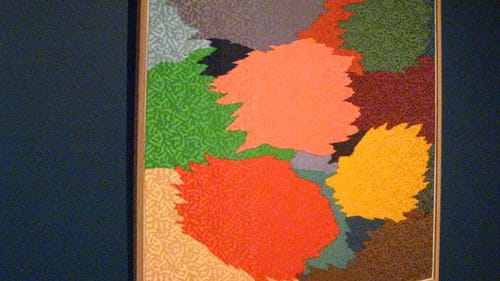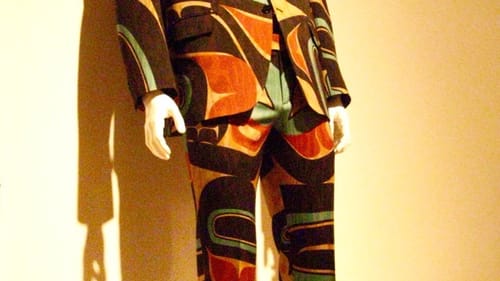Stay in the Loop
BSR publishes on a weekly schedule, with an email newsletter every Wednesday and Thursday morning. There’s no paywall, and subscribing is always free.
Contemporary visions of Native inheritance
Fabric Workshop and Museum presents ‘Echoes and Reverberations’

A reverberation is a sound that repeats over a short distance. Faster than an echo. Fuller than its original sound. A sonic aftershock from the past, thundering into the present. Echoes and Reverberations, at the Fabric Workshop and Museum (FWM), considers the Native American experience as it reverberates through the contemporary work of five artists. The compact exhibition is part of the citywide One Book One Philadelphia celebration, which this year honors There There, a novel of contemporary Native Americans by Tommy Orange.
The artists, Chilkat weaver Anna Brown Ehlers, Cheyenne-Arapaho multidisciplinary artist Edgar Heap of Birds, Tlingit woodcarver Tommy Joseph, Puyukitchum and Ipai performance artist James Luna, and Seneca textile artist Marie Watt, all served residencies with FWM. The works on view, curated from the institution’s collection by Karen Patterson, represent a range of practice.
Preserving Chilkat weaving
Ehlers was born in Juneau and specializes in weaving practiced by the Chilkat people of southeastern Alaska, which incorporates natural materials in blanket fabrication. Symbolizing status, clan history, and believed to carry ancestral spirits, the blankets can take a year to complete, and Ehlers prefers hers to be used ceremonially rather than collected as art.
Her Chilkat Apron (2015) is a triangular garment with a double fringe, the longer one made of strips of smoked moose hide tipped with deer hooves. The field is decorated with totemic birds, wings outstretched, woven in sheep and goat wool.
Chilkat weaving is endangered due to a lack of practitioners, and Ehlers teaches the form to younger Alaskans to preserve it. During her residency at FWM, studio staff helped her research natural dyes, and a case displaying artist working materials has notes from those explorations. A data sheet dated 2013 lists a recipe for blue dye: 50 grams indigo; 1000 g strawberries, bananas, red grapes; 40 g calcium hydroxide. Beneath the formula are swatches showing the results of multiple dips in the solution.
“Who owns history?”
During his residency, the late James Luna worked on High Tech War Shirt (1997-98) and Indian Lounge Suit (1997), both of which he later wore in performance. The shirt, made of hide and horsehair, is studded with round plastic timepieces and gauges along the shoulders, each resting in a hand-beaded nest. The lounge suit, of shiny cranberry fabric, is emblazoned on the back with a silhouette of James Fraser’s iconic sculpture End of the Trail, depicting an exhausted warrior on his horse. Though interesting, these works only hint at Luna’s subversive performance art, such as Take a Picture With a Real Indian, in which he challenged reductive stereotypes.

Text is a hallmark of Edgar Heap of Birds, who draws attention to the cultural struggle of, and injustice inflicted upon, Indigenous peoples. “Fort Pitt Destiny, Anglo Saxon Supremacy, Who Owns History?” reads a fabric remnant from his 1992 residency: a pithy summary of almost any period since Europeans arrived in North America.
“A lot of Native American existence is suppressed in America, so the dominant culture doesn’t tend to know much about the original people that are here so it’s like a secret,” the artist commented in a post on the University of North Texas website. In addition to the link to FWM, Heap of Birds, professor emeritus in Native American studies at the University of Oklahoma, also holds an MFA from Temple’s Tyler School of Art.
Two works from his Neuf Series (1992) are on view: silk jacquard dyed in intense shades—violet, turquoise, sage, bittersweet, and the blue-gray of a gathering storm. The flashes of color summon Heap of Birds’s ancestral homeland in Oklahoma, and it’s possible to imagine that these bright flashes of color are a what a bird sees, soaring through sunset-painted canyons.
A totemic suit
Best known for totem poles, warrior helmets, and bentwood boxes, Tommy Joseph transferred Tlingit iconography onto a man’s suit in My Ancestors (2009-2015). Born in Ketchikan, Alaska, Joseph was introduced to woodcarving in elementary school.
For an artist who conventionally uses traditional woodworking tools and techniques, making a suit was something of a departure. Cut from digitally printed material representing totemic symbols for the eagle and wolf, Joseph wrapped himself in aqua, orange, and black swirls, breathing life and mobility into stories traditionally expressed through a totem pole.

A cave for the future
Stories are also a common thread in Marie Watt’s art. The Seattle-born Seneca artist’s primary form is the blanket, which she views as embodying the maker or makers. Whether working independently or collaborating in a sewing circle, Watt likes to use donated or reclaimed blankets that integrate the past into the new work of art. When owners’ stories are known, Watt records and displays them with the finished work to represent a composite of experience.
In 2009, Watt invited FWM staff and others to hand-felt blankets for Engine, a room-sized, cave-shaped work, which has been reconstructed for this exhibit. It’s a storytelling womb composed of brown blankets framed in wood. Visitors willing to remove their shoes may go inside to hear the tales Indigenous people use to make sense of the world. Soft and smooth underfoot, the dimly lit cave is decorated with boulder-like formations, stalactites, and stalagmites. Pause and listen as four apparitions dance along the walls, telling stories shared across time, in tipis and igloos, around campfires, captured in blankets, kept safe for future generations.
What, When, Where
Echoes and Reverberations. Through March 22, 2020 at Fabric Workshop and Museum, First Floor, 1214 Arch Street, Philadelphia. 215-561-8888 or fabricworkshopandmuseum.org.
The main entrance to FWM is accessible to standard-size wheelchairs, though there are no automatic doors or reserved parking spaces. Wheelchairs are available to borrow on a first-come, first-served basis. For more accessibility info, including ASL interpretation, visit online.
Sign up for our newsletter
All of the week's new articles, all in one place. Sign up for the free weekly BSR newsletters, and don't miss a conversation.
